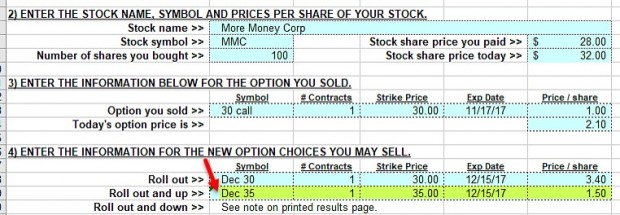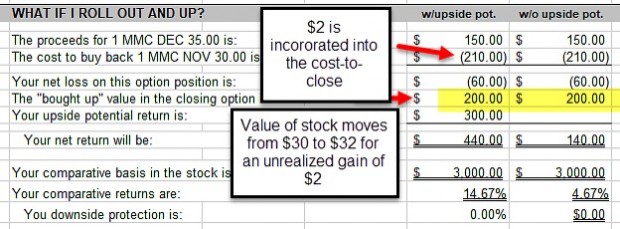One of our covered call writing exit strategies is rolling out-and-up. This involves buying back (buy-to-close) the current in-the-money option and selling the later-date higher strike price. For example, we may buy back the October $50.00 call option and then sell the November $55.00 call option. We would consider such action if the expiring strike is in-the-money, the stock still meets all system criteria and the initial return rolling credit meets our goals. One of the terms used in my books and DVDs associated with this strategy is “bought-up” value. This article will explain the meaning and significance of this term by using a hypothetical example and the “What Now” tab of the Ellman Calculator.
Hypothetical example with made-up stock “More Money Corp. (MMC)”
Current contract month
- Buy MMC for $28.00
- Sell the $30.00 call for $1.00
- Near expiration, MMC is trading at $32.00
- The cost-to-close the $30.00 call is $2.10 ($2.00 is intrinsic value and $0.10 is time value)
- The next-month $35.00 call generates $1.50
The “What Now” tab of the Ellman Calculator
The blue cells of the calculator spreadsheet (left side) are filled in:

Once the information is entered, the white cells on the right side become populated:

What is “bought-up value”?
The bottom (smaller) red arrow shows a bought-up value of $200.00 per contract or $2.00 per share. When we sold the $30.00 call our shares can be worth no more than $30.00 due to our contract obligation. However, when we buy back the option and no longer have that obligation in place, our shares are now worth market value or $32.00. This $2.00 difference or $200.00 per contract represents the “bought–up value”
Why include bought-up value in our calculations?
Since we are including the intrinsic value debit of $2.00 as part of our calculations in the $2.10 cost-to-close, we must also include this intrinsic value component on the asset side. This makes the actual time value cost-to-close $0.10.
Calculation results for rolling out-and-up with MMC
The calculator shows an option debit of $0.60 ($1.50 – $2.10) or $60.00 per contract. Factoring in the “bought-up value of $2.00 or $200.00 per contract, we have a net credit of $140.00 per contract. On a cost-basis (current market value with the contract obligation in place) of $30.00 or $3000.00 per contract, this represents a 4.67% initial return. Should share price rise to the new $35.00 strike by contract expiration, the total rolling out-and-up trade could generate a 1-month return of 14.67%
Discussion
When using the rolling-out-and-up exit strategy for covered call writing, we must factor in the increase is share price when removing the initial obligation. The new “bought-up value” will be current market value or the new strike price, whichever is lower.
Market tone
This week’s economic news of importance:
- Chicago national activity index April 0.34 (0.32 last)
- Markit manufacturing PMI May 56.6 (56.5 last)
- Markit services May 55.7 (54.6 last)
- New home sales April 662,000 (682,000 expected)
- Weekly jobless claims 5/19 234,000 (219,000 expected)
- Existing home sales April 5.46 million (5.5 million expected)
- Durable goods orders April (-)1.7% (-1.0% expected)
- Consumer sentiment index May 98.0 (98.9 expected)
THE WEEK AHEAD
Mon May 28st
- None scheduled
Tue May 29th
- Case-Shiller home price index March
- Consumer confidence index May
Wed May 30th
- ADP employment May
- GDP Q1
- Beige book
Thu May 31st
- Weekly jobless claims through 5/26
- Personal income April
- Consumer spending April
- Core inflation April
- Chicago PMI May
- Pending home sales April
Fri June 1st
- Nonfarm payrolls May
- Unemployment rate May
- Average hourly earnings May
- Markit manufacturing PMI May
- ISM manufacturing index May
- Consumer spending April
For the week, the S&P 500 moved up by o.31% for a year-to-date return of 1.78%
Summary
IBD: Confirmed uptrend
GMI: 6/6- Buy signal since market close of April 18, 2018
BCI: Selling an equal number of in-the-money and out-of-the-money for new positions.
WHAT THE BROAD MARKET INDICATORS (S&P 500 AND VIX) ARE TELLING US
The 6-month charts point to a neutral to slightly bullish tone. In the past six months, the S&P 500 was up 2% while the VIX (13.22) moved up by 36%.
Wishing you much success,
